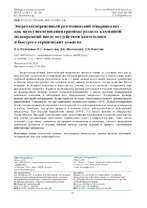| dc.contributor.author | Пилипенко, В. А. | |
| dc.contributor.author | Ковальчук, Н. С. | |
| dc.contributor.author | Шестовский, Д. В. | |
| dc.contributor.author | Жигулин, Д. В. | |
| dc.coverage.spatial | Минск | ru |
| dc.date.accessioned | 2024-07-16T07:51:18Z | |
| dc.date.available | 2024-07-16T07:51:18Z | |
| dc.date.issued | 2024 | |
| dc.identifier.citation | Энергодисперсионный рентгеновский микроанализ – как метод исследования границы раздела алюминий-поликремний после воздействия длительного и быстрого термических отжигов = Energy-Dispersive X-Ray Microanalysis – as a Method for Study the Aluminium-Polysilicon Interface after Exposure with Long-Term and Rapid Thermal Annealing / В. А. Пилипенко [и др.] // Приборы и методы измерений. – 2024. – Т. 15, № 2. – С. 104-109. | ru |
| dc.identifier.uri | https://rep.bntu.by/handle/data/146859 | |
| dc.description.abstract | Энергодисперсионный рентгеновский микроанализ является одним из основных методов по определению элементного состава вещества. Обладая высокой локальностью и относительно малой глубиной проникновения электронного луча (< 1 мкм), данный метод нашёл широкое применение в области микроэлектроники, как основной метод анализа элементного состава вещества. Метод позволяет исследовать поверхность вещества как точечно, так и по площади с построением карт распределения элементов. В работе исследовалось влияние длительной и быстрой термообработок на формирование границы раздела алюминий-поликремний с целью изучения формирования омических контактов в элементной базе интегральных микросхем. Исследование границы раздела алюминий-поликремний осуществлялось методом энергодисперсионного рентгеновского микроанализа. Установлено, что при длительном термическом отжиге (450 ºС, 20 мин) поликремний полностью растворяется в алюминии с последующей его сегрегацией в виде отдельных агломератов в плёнке алюминия, что может привести к полному отказу работоспособности интегральной микросхемы. При быстром термическом отжиге (450 ºС, 7 с) такого явления не обнаружено. Таким образом, быстрый термический отжиг целесообразно использовать в качестве альтернатив- ной замены традиционного длительного термического отжига в микроэлектронике. Такая замена позволяет существенно уменьшить растворение поликремния в алюминии, избежать разрушения омических контактов и поднять процент выхода годных изделий в процессе изготовления интегральных микросхем. | ru |
| dc.language.iso | ru | ru |
| dc.publisher | БНТУ | ru |
| dc.title | Энергодисперсионный рентгеновский микроанализ – как метод исследования границы раздела алюминий-поликремний после воздействия длительного и быстрого термических отжигов | ru |
| dc.title.alternative | Energy-Dispersive X-Ray Microanalysis – as a Method for Study the Aluminium-Polysilicon Interface after Exposure with Long-Term and Rapid Thermal Annealing | ru |
| dc.type | Article | ru |
| dc.identifier.doi | 10.21122/2220-9506-2024-15-2-104-109 | |
| local.description.annotation | Energy dispersive X-ray microanalysis is one of the main methods for determining the elemental composition of matter. Possessing high locality and a relatively shallow penetration depth of the electron beam (< 1 μm), this method has found wide application in the field of microelectronics, as the main method for analyzing the elemental composition of matter. The method allows to study the surface of a substance both pointwise and over an area with the construction of element distribution maps. In the paper we investigated the influence of long-term and rapid heat treatments on the formation of the aluminum-polysilicon interface in order to study the formation of ohmic contacts in the element base of integrated circuits. The aluminumpolysilicon interface was studied using energy-dispersive X-ray microanalysis. It has been established that during long-term thermal annealing (450 °C, 20 min) polysilicon is completely dissolved in aluminum followed by its segregation in the form of separate agglomerates in the aluminum film, which can lead to a complete failure of the integrated circuit. During rapid thermal annealing (450 °C, 7 s) such a phenomenon was not detected. Thus it is advisable to use rapid thermal annealing as an alternative to traditional long-term thermal annealing in microelectronics. This makes it possible to significantly reduce the dissolution of polysilicon in aluminum, avoid the destruction of ohmic contacts and increase the percentage of yield of workable 0products in the process of integrated circuits' manufacturing. | ru |

